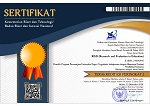Developing assessment instruments for the sensory acceptability of food products
DOI:
https://doi.org/10.21831/reid.v3i1.13940Keywords:
physiological instrument, psychological instrument, sensory instrumentAbstract
References
Azwar, S. (2000). Sikap manusia: Teori dan pengukurannya (2nd ed.). Yogyakarta: Pustaka Pelajar.
Bartko, J. J. (1976). On various intraclass correlation reliability coefficients. Psychological Bulletin, 83(5), 762–765. https://doi.org/10.1037/0033-2909.83.5.762
Borg, W. R., & Gall, M. D. (1989). Educational research: An introduction (5th ed.). New York, NY: Longman.
Brennan, R. L. (2006). Educational measurement (4th ed.). Westport, CT: Praeger.
Cizek, G. J., & Bunch, M. B. (2007). Standard setting: A guide to establishing and evaluating performance standards on tests. Thousand Oaks, CA: Sage Publications.
Mardapi, D. (2008). Teknik penyusunan instrumen tes dan nontes. Yogyakarta: Mitra Cendekia.
Mason, R. L., & Nottingham, S. M. (2002). Sensory evaluation manual. Phitsanulok, Thailand: Naresuan University.
Murti, B. (2011). Validitas dan reliabilitas pengukuran. In Matrikulasi Program Studi Doktoral. Surakarta: Fakultas Kedokteran, Universitas Sebelas Maret.
Rakhmat, J. (2007). Psikologi komunikasi. Bandung: Remaja Rosdakarya.
Shumate, S. R., Surles, J., Johnson, R. L., & Penny, J. (2007). The effects of the number of scale points and non-normality on the generalizability coefficient: A Monte Carlo study. Applied Measurement in Education, 20(4), 357–376. https://doi.org/10.1080/08957340701429645
Stone, H., & Sidel, J. L. (2004). Sensory evaluation practices (3rd ed.). Waltham, MA: Academic Press. https://doi.org/10.1016/B978-012672690-9/50013-5
Walgito, B. (1989). Pengantar psikologi umum (Rev. ed.). Yogyakarta: Andi Offset.
Watts, B. M., Ylimaki, G. L., Jeffery, L. E., & Elias, L. G. (1989). Basic sensory methods for food evaluation. Ottawa, Ontario: International Development Research Centre.Downloads
Published
How to Cite
Issue
Section
Citation Check
License
The authors submitting a manuscript to this journal agree that, if accepted for publication, copyright publishing of the submission shall be assigned to REID (Research and Evaluation in Education). However, even though the journal asks for a copyright transfer, the authors retain (or are granted back) significant scholarly rights.
The copyright transfer agreement form can be downloaded here: [REID Copyright Transfer Agreement Form]
The copyright form should be signed originally and sent to the Editorial Office through email to reid.ppsuny@uny.ac.id

REID (Research and Evaluation in Education) by http://journal.uny.ac.id/index.php/reid is licensed under a Creative Commons Attribution-ShareAlike 4.0 International License.







.png)





